![]()
![]()
![]()
Use LEFT and RIGHT arrow keys to navigate between flashcards;
Use UP and DOWN arrow keys to flip the card;
H to show hint;
A reads text to speech;
42 Cards in this Set
- Front
- Back
|
Additive color |
Created using beams of light. Red, blue, green. RBG Used by website artists, videographers and lighting designers. |
|
|
Subtractive color |
Created when white light is reflected off a pigmented or dyed surface. Primaries are blue, red and yellow. Used by painters, printmakers and illustrators. Pigments and dyes |
|
|
Process colors |
CMYK |
|
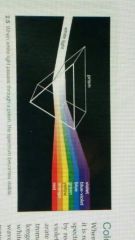
|
Light is refracted/bent through prism. Red has longest wavelength. Violet has shortest. |
|
|
Color overtones |
A secondary hue bias in a primary color. Ex alizarin crimson: red w/ violet overtones |
|
|
Achromatic |
Black & white. No hue |
|
|
Bezold effect |
Influence of color interaction. The change in a single color can alter our perception of a PATTERN |
|
|
Opponent theory |
Red& blue. Cones can register only one color in a complementary pair at a time. |
|
|
Hue |
The name of a color. Red, blue, green, yellow. |
|
|
Primary |
Red, yellow, blue |
|
|
Secondary |
Green, orange, violet |
|
|
Tetriary |
Mixture of secondary color and adjacent primary color |
|
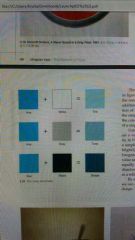
|
Tint, tone, shade |
|
|
Monochromatic |
A single hue |
|
|
Analogous |
Adjacent colors on the wheel. Ex: green, blue green, blue |
|
|
Complementary color |
On opposite sides of color wheel. When mixed together, can produce brown or lower intensity. |
|
|
Split complementary |
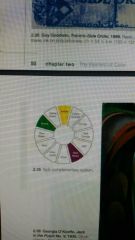
Two colors on either side of the complements.
Green, red, violet and yellow |
|
|
Triadic |
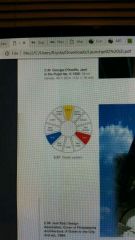
Equally spaced apart. Ex: yellow, blue, red |
|
|
Chromatic gray |
Mixture of hues and rather than just black and white. |
|
|
Color key |

A dominant color. Can heighten psychological and compositional impact. |
|
|
According to opponent theory, the physiognomy of our eyes |
Limits the ability to view more than one complementary pair of colors at a time |
|
|
A colors purity is not related to its |
Temperate |
|
|
The color combination in Georgia o Keefes jack in the pulpit no. V |
Split complimentary |
|
|
Chromatic grays are unique because |
They are formed using a mix of color rather than just b&w |
|
|
Adding white to an image creates |
Tint |
|
|
Which is NOT TRUE about color |
Color values can be manipulated in a painting but not in a photograph |
|
|
Which is true about color temp? |
All of the above statements |
|
|
Which is true of color disharmony? |
None of the answers |
|
|
Which is true about the additive color system? |
It is, used to create graphics on computer. RGB |
|
|
Critique that focuses on the formal elements |
Objective criticism |
|
|
Can be described as the physical manifestation of an idea |
Form |
|
|
Robert Rauschenberg experimented with _______ to create 3 different versions of monogram, a work that combined 3d and 2d elements |
Compositional change |
|
|
The content of the work of art is the |
Intellectual or emotional message in the artwork |
|
|
Sculptures by claes Oldenburg and coosje van bruggen often involve |
Transformation in the medium and scale of objects |
|
|
Cause and effect critique |
All of the above |
|
|
All of the following questions are worth considering when critiquing a composition except |
Will it require an explanation from the artist |
|
|
Shared language, iconography and ____ can help to communicate and build meaning from a work of art |
Historical and cultural literacy |
|
|
Mark Schallers "some words" utilized ____ as a means of meditating on the act of thinking |
Stream of consciousness texts |
|
|
Shi Jinsongs metallic sculpture Na Zha Cradle is an example of |
A metaphorical comment on the effects of capitalism |
|
|
Tetrad |
4colors equidistant on a color wheel |
|
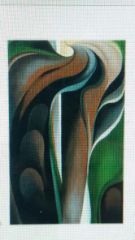
Georgia o keef jack and the pulpit |
Dominated by greens and and voilets. Split complimentary Green, red violet and yellow. |
|
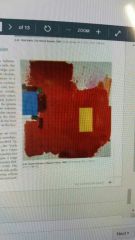
Hans Homann magnum opus |
Creates the illusion of space. Creates a push and pull effect with color. Nonobjective composition. Red dominates. Blue pulls inward, yellow pushes out. |

